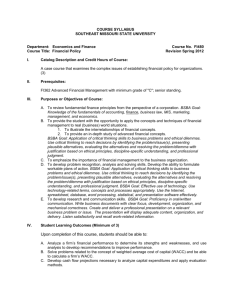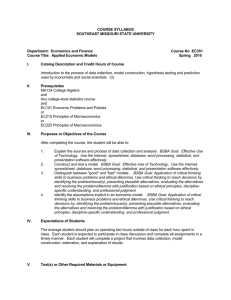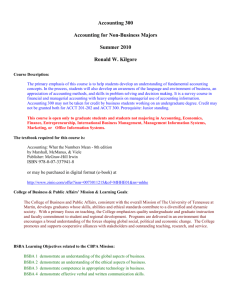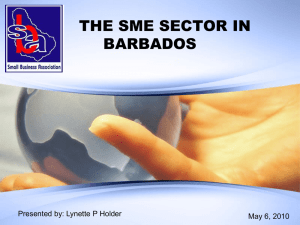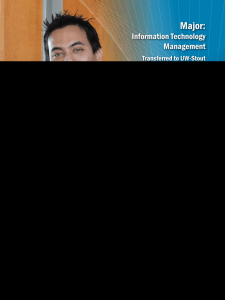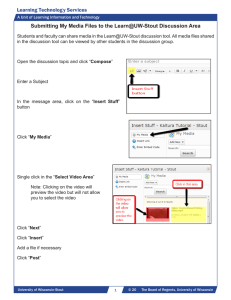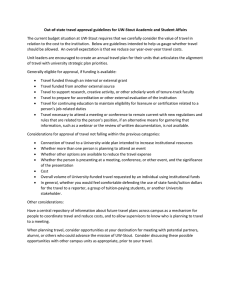Program Director Self-Study Report
advertisement
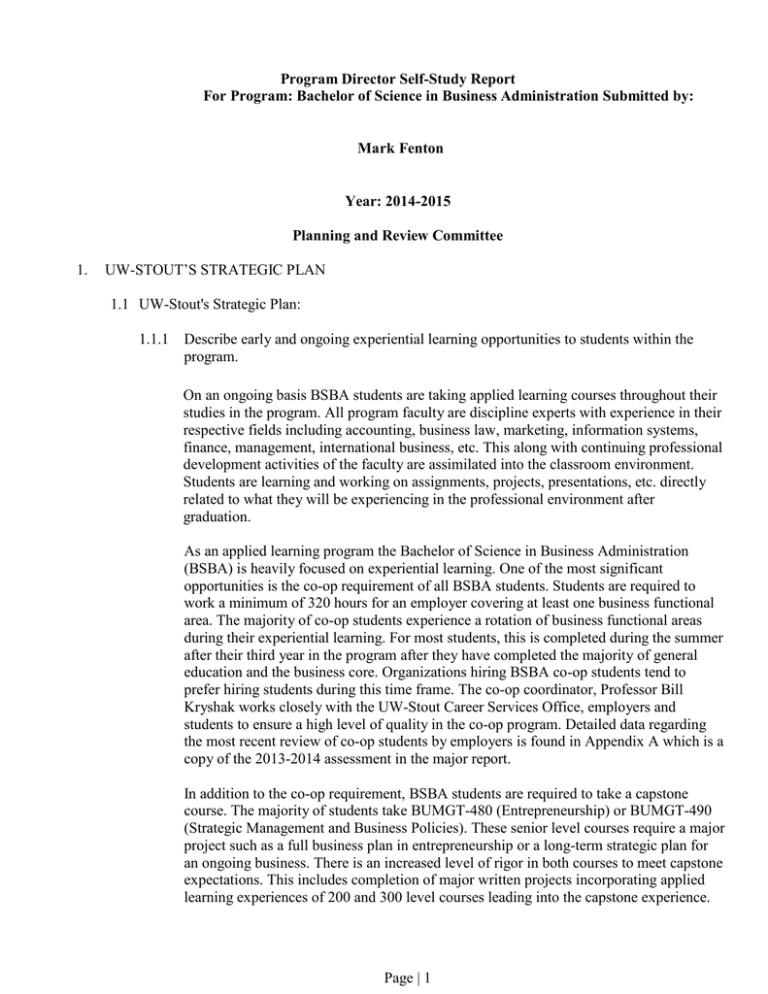
Program Director Self-Study Report For Program: Bachelor of Science in Business Administration Submitted by: Mark Fenton Year: 2014-2015 Planning and Review Committee 1. UW-STOUT’S STRATEGIC PLAN 1.1 UW-Stout's Strategic Plan: 1.1.1 Describe early and ongoing experiential learning opportunities to students within the program. On an ongoing basis BSBA students are taking applied learning courses throughout their studies in the program. All program faculty are discipline experts with experience in their respective fields including accounting, business law, marketing, information systems, finance, management, international business, etc. This along with continuing professional development activities of the faculty are assimilated into the classroom environment. Students are learning and working on assignments, projects, presentations, etc. directly related to what they will be experiencing in the professional environment after graduation. As an applied learning program the Bachelor of Science in Business Administration (BSBA) is heavily focused on experiential learning. One of the most significant opportunities is the co-op requirement of all BSBA students. Students are required to work a minimum of 320 hours for an employer covering at least one business functional area. The majority of co-op students experience a rotation of business functional areas during their experiential learning. For most students, this is completed during the summer after their third year in the program after they have completed the majority of general education and the business core. Organizations hiring BSBA co-op students tend to prefer hiring students during this time frame. The co-op coordinator, Professor Bill Kryshak works closely with the UW-Stout Career Services Office, employers and students to ensure a high level of quality in the co-op program. Detailed data regarding the most recent review of co-op students by employers is found in Appendix A which is a copy of the 2013-2014 assessment in the major report. In addition to the co-op requirement, BSBA students are required to take a capstone course. The majority of students take BUMGT-480 (Entrepreneurship) or BUMGT-490 (Strategic Management and Business Policies). These senior level courses require a major project such as a full business plan in entrepreneurship or a long-term strategic plan for an ongoing business. There is an increased level of rigor in both courses to meet capstone expectations. This includes completion of major written projects incorporating applied learning experiences of 200 and 300 level courses leading into the capstone experience. Page | 1 The majority of students in the capstone courses perform well on the major projects and presentations. 1.1.2 Describe program initiatives employed to support and/or increase student enrollment, retention and graduation rates? Enrollment Since the last planning and review report, the number of BSBA students in the program has dipped. See Table 1 below. In 2008 and 2009, enrollment was approximately 800 students. This was during a global recession and historically enrollments increase with the economy falters. Other possible explanations for the decrease in enrollment could be due to three new programs related to business which are offered online only including the BS in Management program with over 400 students. These additional options may be attracting students who would otherwise become BSBA majors. In addition, since the last report in 2007-2008 the BS in Supply Chain Management, the BS in Golf Enterprise Management, and the BS in Real Estate and Property Management have had steady growth over the same period. In addition, the numbers reflect the first declared major. Many students in the programs noted above are double majors with the BSBA program, but are not counted as BSBA majors if their first declared major is not BSBA. One item of note is the BSBA program number of 688 for 20132014 is low because the number was generated while we were still accepting transfer and new students. The current enrollment is 731 students. Table 1: Three Year Enrollment (Planning Assessment Review and Quality) In terms of plans or initiatives employed to support and/or increase student enrollment, retention and graduation rates, the BSBA program is very proactive. Recruitment On a continuing basis, several program faculty meet with prospective students during campus visits. Other ongoing activities include campus preview days and Stout Saturdays when the Program Director meets with prospective students and often their parents. Feedback from perspective students indicates meeting with faculty and the program director have a positive impact on their decision to come to UW-Stout. Page | 2 At the beginning of each academic year, representatives from the admissions office meet with the program director to review talking points about the BSBA program and provide an update on what is new in the program or coming up. Information would include many of the topics covered in the assessment in major report, such as program and course revisions which are designed to improve student preparedness as well as retention. This past summer, the BSBA program reached out to all students who had been admitted to the BSBA program as freshmen or transfer students welcoming them to UW-Stout. While not all who are admitted come to UW-Stout, reaching out from a program standpoint rather than just hearing from Admissions can be beneficial. International Reach One of the initiatives to increase enrollment has been the increasing number of degree completion agreements with universities in China and Saudi Arabia. The BSBA program has had a steady increase in the numbers of students from China. In addition, the program has been working on a new degree completion program with Namseoul University in South Korea. Marketing The BSBA program needs to improve marketing efforts. This year (2014), After completing a program study, the program director met with Amy Luethmers in University Marketing. Amy put together a marketing plan which also included additional outreach to transfer students. The College of Management does not have a budget for additional program marketing at this time and the plan has not yet been implemented. Fortunately, Amy had grant funding this past year to use for marketing to transfer students and part of those funds were used in support of marketing the BSBA program. More needs to be done. Marketing the program is among the major topics on the next advisory board meeting. Graduation Rates Ultimately, ensuring students are meeting program and course objectives successfully has significant impact on graduation rates. While not enough time has elapsed since the 2013 program revision, it is expected graduation rates will increase. The BSBA program has reduced credits to degree to 120 from 124. In addition, the program worked with the math, statistics and computer science department to complete a course and prerequisite revision to MATH-123 (Finite Math with Business Finance Applications). This is the math requirement for the BSBA program. In the past, some students have taken up to 16 credits of math to meet the program requirement. The math placement level for MATH-123 was reduced to a 2 from 3 on a 0 (zero) to 4 scale. In addition, those students scoring a 1(Intermediate Algebra) will still need to take MATH-110, but the minimum course grade to go directly to MATH-123 from MATH-110 has gone to a C+ from the previous B- or better requirement. Historically, when BSBA students take BUACT-206 and earn a grade lower than a C, they tend to do poorly in BUACT-207 and their advanced accounting requirement. This behavior may lead to students transferring or not completing a UW-Stout degree. The accounting faculty have been considering a minimum grade for BSBA program majors. Page | 3 1.1.3 Describe, provide examples and explain how the program intentionally integrates diversity efforts, functions and contributes to the program in support of Inclusive Excellence: “UWStout’s plan to intentionally integrate diversity efforts into the core aspects of everything we do. Diversity is broadly defined and includes, but is not limited to, race/ethnicity, gender, sexual orientation, age and disability status.” During the past four years, the Nakatani Teaching and Learning Center has sponsored yearlong diversity projects for faculty. Several business department faculty members have participated in one of these professional development projects including the program director. Faculty are able to take this knowledge to the classroom, disseminate it with colleagues and some have done conference presentations. One of these was an academic year project on developing diversity content for a course. The faculty member developed a diversity project for their international business course. The project addressed the professional roles of women in the workplace in different countries/cultures. This project was also presented at the 2013 National Association for Multicultural Education annual conference in Oakland, California. Several of the courses offered by the business and operation and management departments have strong cultural and gender diversity components. These include International Business, International Management, Organizational Leadership, and Inclusivity in Leadership. Under the revised general education at UW-Stout, in the contemporary issues category, the BSBA program director has been recommending students consider taking WGS-210 (Introduction to Women & Gender Studies) as a racial and ethnic studies A (RESA) course. 1.1.4 Describe environmental sustainability initiatives embedded and supported by the program: “UW-Stout’s attempt to make students, faculty, and staff more aware of the importance of sustaining our environment through energy conservation, waste reduction, and other measures that will not bring harm to the environment, and to provide students with innovative research opportunities in these areas.” The BSBA program has an emphasis area requirement all students must meet. One of the emphasis areas is sustainability and the environment. Students take a minimum of four related courses. Paper usage has gone down as more faculty are using Learn@UW-Stout to distribute handouts electronically and as a tool for giving exams. 2. DESCRIPTION OF THE PROGRAM 2.1 Curriculum Design 2.1.1 BSBA Program Objectives 1. Contribute to industry through the application of business and management principles. 2. Implement the systems and processes of the enterprise. 3. Use critical thinking skills and apply quantitative and qualitative information to evaluate and solve problems, and make sound decisions. 4. Implement the concepts of group dynamics/teamwork in achieving organizational goals. 5. Apply concepts of ethical behavior in decision making. 6. Apply quality principles to assure stakeholder satisfaction. Page | 4 7. Utilize a variety of management approaches, techniques, and tools. 8. Demonstrate an awareness of cultural and global competencies in an increasingly diverse marketplace. 2.1.2 Describe processes and initiatives employed in determining the need for program revision? During the 2012-2013 academic year, the BSBA program went through a major revision to meet the requirement of 120 credits to degree (down from 124) and the UW-Stout revision to general education. The revised program was implemented in the fall of 2013. Please see Appendix B for a copy of the program changes. Since this time, a new program revision has not been done. However, when determining the need for a revision, several factors are taken into account. First, the advice of the BSBA advisory board is salient to a program revision. The advisory board is the key conduit the program director has to business and industry. A major goal of the BSBA program is to have graduates fully prepared to join the professional ranks upon successful completion of their degree program. The advisory board helps to guide the program director in curricular development to ensure student preparedness. Additional incentives are driven by student competencies. Currently, the BSBA program, faculty and advisory board are considering a minimum grade in BUACT-206 and BUACT-207 for business majors only. Data is being collected to determine if a minimum grade in each of these accounting courses will improve applied knowledge retention as student move into their upper level courses which also use an accounting component. Other initiatives in determining the need for a program revision include periodic audits of program offerings and working with other UW-Stout departments with significant numbers of BSBA students in the respective courses offered. 2.1.3 Check all that apply regarding the program: X Traditional, on campus program (Note: The BSBA program offers a significant number of online courses to BSBA students. The majority of these offerings are in the business core and mainly taught during the WinTerm and summer sessions.) Offsite location Online program 2.1.4 Briefly describe the components of your program where students participate in scholarly activity such as: research, scholarship, experiential learning and creative endeavor. “programs are presented through an approach to learning which involves combining theory, practice and experimentation” (UW-Stout’s Mission Statement) While BSBA students perform various kinds of research in many core and professional studies courses, the capstone courses provide the most opportunity for research and scholarship. In Entrepreneurship and in Strategic Management and Business Policies, students have a major research project. In Entrepreneurship, students complete an actionable full business plan. In Strategic Management and Business Policies, students write a proposed strategic management plan for an established organization. In both cases, students also complete presentations of their work. BUMKG-479 (Marketing Research) incorporates experimental and survey techniques to secure information for successful marketing; primary Page | 5 and secondary sources; data collection, compilation and analysis methods; effective communication of conclusions and recommendations to management. Experiential learning is a program requirement. BSBA students complete a co-op, internship, or field experience. This is generally done the summer after their junior year. The majority, 99% do a paid co-op. The co-op must be a minimum of 320 work hours, have clearly defined work objectives, complete two reports from the student and two from the employer, and to present their co-op experience to fellow students in the following semester. 2.1.5 Does your program currently have an accreditation or certification agency that reviews the program? If so, which agency and to what extent does it influence the structure of the curriculum? The Accreditation Council for Business School and Programs (ACBSP) granted initial accreditation in June of 2012. This was done after a three year self-study and follow-up from mentor and program visits. The initial accreditation is for 10 years. ACBSP considers several factors in granting accreditation. For students, there are 12 common professional components they are evaluated on. As part of continuing accreditation, the BSBA program administers the Peregrine Assessment in Major exam to seniors in their capstone courses (BUMGT-480: Entrepreneurship and BUMGT-490: Strategic Planning). Seniors take a 120 question exam covering 12 Common Professional Components (CPC) topics. These include: 1. Accounting 2. Business Ethics 3. Business Finance 4. Business Integration and Strategic Management 5. Business Leadership 6. Economics (Macro and Micro) 7. Global Dimensions of Business 8. Information Management Systems 9. Legal Environment of Business 10. Management (Operations/Production Management, Human Resource Management, and Organizational Behavior.) 11. Marketing 12. Quantitative Techniques and Business Statistics 2.2 Faculty/Academic Staff Expertise – Respond to the following: 2.2.1 List key instructors in the program. A key instructor is one who teaches at least one required professional course in your program. Professor Charles Baird Dr. Anne Hoel Dr. Rao Gundala Professor Gene Gutman Dr. David Johnson Professor William Kryshak Dr. Paul Lokken Page | 6 Dr. Kevin McDonald Dr. Brian Oenga Professor Craig Moore Professor Jill Paetzold Professor Kelly Schultz Mr. Evan Sveum Dr. Dennis Vanden Bloomen Mr. Scot Vaver Dr. Mitch Sherman 2.2.2 What additional faculty/academic staff expertise is needed? Faculty have the necessary expertise needed to meet program and course objectives. However, the business department is in need of additional FTE. The department has two accounting positions open which are being filled with adjunct instructors. A search and screen process has begun. Due to high demand in the accounting and marketing areas, additional FTE would reduce the pressure for overloading sections. While the number of students in the BSBA program is lower than it was 10 years ago, the number of students the business department serves has grown at a steady rate as new programs come online and grow. Business program faculty teach students from at least 13 different programs across campus which include 5 programs which did not exist 10 years ago. In addition, the business minor is the largest minor program at UW-Stout and serves students in many more degree programs. 2.3 Facilities – Respond to the following: 2.3.1 Describe facilities and or capital equipment currently used and how it supports or strengthens the program? What program specific facilities (unique classrooms, labs, additional space involving minor construction) have been requested and provided? The BSBA program has two dedicated accounting classrooms including one with smartboard technology. In addition, the program has tutor labs for accounting, logistics and decision support systems courses. The tutor locations have moved from their normal location of 279 Tech Wing during the remodeling of Harvey Hall. As a result, finding space for the tutor labs is a challenge. The program now has a dedicated marketing lab used by several faculty members. The addition of the marketing lab has been a bonus for the program. This lab in the Jarvis Hall Science Wing was designed with marketing research in mind. The marketing research students have used this lab to meet with clients and to conduct primary research. The lab has a multifunction layout with a larger classroom and three smaller meeting rooms for conducting research and market testing. In addition, this lab is used for research and meeting with in-the-field supply chain experts by students and faculty in the Bachelor of Science in Supply Chain Management. This lab has become a critical asset for students in multiple programs in the College of Management. 2.3.2 What added facility needs (if any) such as unique classrooms, labs, additional space involving minor construction exist in the program? With the increased number of students in many programs taking courses offered by the Page | 7 business faculty, an additional dedicated accounting space would allow more students to take accounting in these uniquely designed classrooms. 2.4 Resources for the Program – Respond to the following: 2.4.1 Evaluate the quality, relevance, and quantity of the library resources to support the program. Include a brief statement as to how these needs have been met by the library. Capstone courses, international business, international management, several of the marketing courses, and others use library resources. The Robert S. Swanson Library Learning Center (RSSLLC) does an excellent job of meeting program needs for these and other courses. Each year, the library reaches out to program faculty to identify any additional or continuing resources faculty need for their respective courses. The RSSLLC’s web site is well designed and developed to facilitate student and faculty research. 2.4.2 List any special resources used to meet program and/or student needs such as: Learning Technology Services for curriculum materials development, ASPIRE, Research Services, Advisement Center, Disability Services, Multicultural Student Services, etc. The Advisement Center works closely with first year students in the BSBA program to help identify initial courses and to work with students who are having a difficult time transitioning to life away from home. In addition, program faculty work with Disability Services for students with documented needs. This mostly is for testing purposes such as a quiet room or extended time. Several program faculty use Research Services as part of their individual research and grant writing activities. Research Services was instrumental this past year in helping secure a $100,000 federal grant from the United States Department of State. 2.4.3 3. Describe other resources (if any) needed to meet the program objectives? Changing technology is a long running trend. One of these trends is the increasing use of social media as a marketing tool. To that end, in 2013 the business department added a new marketing course; BUMKG-391 (Social Media Marketing Management). This course is growing in demand. It is currently offered one time a year. The BSBA program director would like to see it offered at least one additional time each year. With the increased popularity of BUMKG-391 and BUMKG-350 (E-Business Strategy and Practice), additional lab space and social media design software whether it is open sourced such as Dolphin, Phpizabi or commercial software such as Nimble and SocialEngin PHP could be beneficial to the BSBA program. Quality of the graduates of the program – Respond to the following: 3.1 Describe program graduate demand and/or anticipated changes or trends impacting the future demand. The current placement rate for graduates of the BSBA program is 99% employed or continuing their education. Demand for program graduates has been steady and this trend is expected to continue. One of the things which make the BSBA program at UW-Stout unique is that it is a multifunctional business degree. Students have applied learning courses in marketing, accounting, management, information systems, business law and many others. This approach Page | 8 allows employers to place graduates in different areas of an organization. There is a growing demand by students in the BSBA program to have the option of earning a minor in marketing in addition to their degree program. The business department offers 11 BUMKG and 2 BUSCM courses from which a minor in marketing could be developed. One of the BUMKG courses is BUMKG-346 (Seminar), this course could be revised to incorporate additional marketing analytics. 3.2 Interpret the data provided by the Planning, Assessment, Research and Quality (PARQ) office of the alumni follow-up surveys. Alumni Follow-Up Survey (Program Specific) The one-year follow-up survey of graduates addresses how well UW-Stout in general and the BSBA program specifically, prepared students for professional life. The latest data is available for 2012 graduates. Of 163 possible respondents, 28 returned the survey for a response rate of 17%. Fourteen quantitative questions are asked using a five point Likert scale with 5=excellent, 4=above average, 3=average, 2=below average, 1=poor. See the below prepared by the Planning, Assessment, Research, and Quality office. Table 2: One Year Alumni Follow-Up Survey (Program Specific Questions) How well did your university experiences, both in and out of the classroom, prepare you in the following areas? (1 = Poor; 5 = Excellent) General business management problem-solving 3.8 Business writing 3.8 Information technology usage 3.8 Economics 3.1 Production/operations management 3.7 Accounting 3.8 The management of people 4.0 Business law 3.6 Marketing 4.1 Sales and sales management 3.8 Business finance 3.7 International/global business 3.1 Integrated business analysis 3.3 Did your coursework in management and other experiences at Stout prepare you 3.85 to effectively motivate diverse individuals to work hard and well in the best interest of their employer? Generally BSBA one year graduates held a favorable opinion of how prepared they were when graduating and moving into the professional environment. While functional topics noted in Table 2 are generally very positive, economics and international business ranked closer to average. BSBA students are required to take a macroeconomics and microeconomics course. This may be the only economics course a student takes. In 2013, faculty academic advisors met with many of the economics faculty to discuss encouraging more BSBA students to get a minor in economics. There are more students in the economics minor, but the number is not up significantly. Beginning next term, the BSBA program director will be inviting an economics professor to address the significance of understanding economics in business. Additional guest speakers from business and industry who are invited generally ask the program director for a list of talking point ideas. Understanding economics will be added to the list. For international business, BSBA program students are required to have only one international course. The majority take BUINB260 (Introduction to International Business). While a comprehensive course, this course alone would not fully prepare a student. Page | 9 The five-year follow-up survey of graduates addresses how well UW-Stout in general and the BSBA program specifically, prepared students for professional life. The data below is from a program specific survey sent to 2008 BSBA program graduates. Twenty seven graduates responded to the survey for a response rate of 17%. Fourteen quantitative questions were asked using a five point Likert scale with 5=excellent, 4=above average, 3=average, 2=below average, 1=poor. See the below prepared by the Planning, Assessment, Research, and Quality office. Table 3: Five Year Alumni Follow-Up Survey (Program Specific Questions) How well did your university experiences, both in and out of the classroom, prepare you in the following areas? (1 = Poor; 5 = Excellent) General business management problem-solving 3.96 Business writing 3.59 Information technology usage 4.07 Economics 3.48 Production/operations management 3.50 Accounting 3.7 The management of people 3.89 Business law 3.59 Marketing 3.93 Sales and sales management 3.67 Business finance 3.89 International/global business 3.26 Integrated business analysis 3.48 Did your coursework in management and other experiences at Stout prepare you 3.59 to effectively motivate diverse individuals to work hard and well in the best interest of their employer? In comparing the 2012 data to the 2008 data, mean scores were not statistically dissimilar and respondents tended to view their professional preparation at UW-Stout favorably. As with the one year data, economics and international business were generally lower than the other functional areas and are being addressed as noted earlier. One item of note, the current program director is just beginning their fourth year in the role. The program director is a strong supporter of international business related education including short-term (1-3 week faculty led programs) and long-term (summer, semester, or academic year) study abroad opportunities for BSBA students. The program director works closely with the Office of International Education to promote study abroad activities. In the past three years, the number of students going on a study abroad experience has increased. In particular the number going on short-term faculty led programs has increased. The response rate for both one-year and five-year graduates are quite low. It is recommended the program director be a part of the data collection process by including a message of appreciation with the invitation to participate in the data collection. 3.3 Interpret program specific surveys (students, faculty and advisory committee) conducted by the Planning and Review Committee. PRC Student Surveys, Key Instructor Surveys and Advisory Board Member Surveys Every seven years, the BSBA program submits a program review report to the university. In the current year (2014), the BSBA program is up for review. Data was collected from three key stakeholder groups in the spring of 2014; junior/senior students, key faculty, and the BSBA Advisory Board. Below is a summary for each group. Page | 10 Juniors and seniors were asked 20 questions for the Planning and Review Committee (PRC). The questions related to resources available at UW-Stout, skills development, instruction, advisement, program specific topics and impressions. A five point Likert Scale was used with 1=strongly disagree, 2=disagree, 3=neutral, 4=agree and 5=strongly agree. Out of 376 possible respondents, 69 participated. See the table below for question and the mean score. Table 4: Planning and Review Committee Student Survey Question 1. The library resources and access to collections are adequate for my program of study. 2. My written communication skills have been enhanced through my coursework. 3. My oral communication skills have been enhanced through my coursework. 4. My critical thinking skills have been enhanced through my coursework. 5. My problem solving skills have been enhanced through my coursework. 6. The classroom facilities meet the needs of students in my program. 7. The laboratory equipment for my program is up-to-date. 8. My advisor is accessible on a routine basis. 9. Instructors in my program are accessible for help outside of regular class time. 10. Instructors in my program provide current and relevant information. 11. Instructors in my program achieve the stated objectives as presented in their course syllabi. 12. The evaluation procedures for my courses in my program appropriately measure my learning. 13. My program's objectives were made clear to me and are being met. 14. My program has few or no problems with unnecessary repetition or overlap of content. 15. My program requirements can be completed in a reasonable time. 16. As I near the completion of my degree, I feel confident that my program has prepared me to beOverall, successful profession. 17. this in is amy quality program. 18. If I had to do it all over again, I would choose this program. 19. The coursework in ethnic studies that I have taken discourages racism and has given me a greater appreciation ethnic diversity. 20. I have developedofa global perspective. Mean 3.74 4.01 4.07 4.04 4.16 3.75 3.58 3.91 4.22 4.03 4.07 3.78 3.99 3.46 3.62 3.78 3.99 3.72 3.42 3.54 Overall, respondents leaned to agree and strongly agree. The next time this report is generated students need to be encouraged to take the survey to improve response rate. A five point Likert Scale was used with 1=strongly disagree, 2=disagree, 3=neutral, 4=agree and 5=strongly agree. The response rate for this survey was 18%. Page | 11 Sixteen key instructors were identified for the PRC survey. Eleven responded for a response rate of 69%. Instructors were asked 13 questions to rate instructional technology, classroom facilities, student preparedness, program information and communication, clerical support and research. See the table below for each question and the mean score. Table 5: Planning and Review Committee Key Instructor Survey Question 1. Quality of classroom facilities for my course(s) is adequate. 2. Quality of laboratory facilities for my course(s) is adequate (if applicable) 3. Instructional technology for my course(s) is adequate. 4. I received adequate training to develop my online course site (D2L). 5. The students entering my course(s) are adequately prepared to be successful. 6. Communication between me and the program director is satisfactory. 7. Program Director's leadership is satisfactory. 8. I have the opportunity to participate in program decisions. 9. Departments schedule an adequate number of course sections. 10. Clerical support for my course(s) is adequate. 11. Supplies for my course(s) are adequate. 12. The Library meets the needs of the students in my class (es). 13. The Library meets my needs for research and professional development. Mean 4.27 3.67 4.36 4.00 3.82 4.36 4.55 3.64 3.55 4.45 4.36 4.18 4.00 Of the 11 respondents, the mean was in the ‘agree’ to ‘strongly agree’ range. The lower mean in number 2 can be attributed to the majority of business courses, outside of marketing courses, do not use lab facilities and for number 9 resources are stretched to their maximum. . Nine of sixteen members of the advisory board responded to the PRC survey. This survey focuses on the advisory board’s impact on the BSBA program, to make suggestions for program development, and to work with the program director to ensure students are meeting the needs of business and industry when graduating. It should be noted, the BSBA advisory board make-up has changed since the survey was taken and at least one formal meeting has been held. There were four quantitative questions. See the table below. Table 6: Planning and Review Committee Advisory Board Survey Question Response Do you feel the committee should meet more frequently? Yes=5 Does the program share student learning data? Yes=7 Does the program advisory committee have the Yes=6 opportunity to provide recommendations to the program? Do advisory committee recommendations impact Yes=7 program’s decisions? No=3 No=1 No=2 No=1 The BSBA program has been expanding the number of external advisory board members. In 2014, two new external members and one internal new member have joined the advisory board. Significant discussions at advisory board meetings in the future will be how to market the program with limited funding available. Page | 12 4. Program evidence of continuous improvement – Respond to the following: 4.1 Describe program strengths distinguishing it from similar programs. Describe and explain program weaknesses? The following universities within Wisconsin, Minnesota, North Dakota, Michigan and Illinois have what could be described as a similar business administration degree: UW- Eau Claire, UWRiver Falls, UW-Platteville, MNSCU-Moorhead, UW-GB, UW-Stevens Point, UW-Parkside, UW-Superior, MNSCU-Bemidji, MNSCU-Winona, MNSCU- Metropolitan State, MNSCUSouthwest, ND-Dickinson, ND-Mayville, ND-State University, ND-Valley City, Ferris State Michigan, Central Michigan, Illinois State University, Northern Illinois, Southern Illinois Carbondale, Drake University of Iowa. While this is a significant number of universities, there are at least 12 different distinguishing opportunities for the UW-Stout BSBA program. The top strengths are: More multifunctional business areas are covered compared to the majority of other programs listed. More than 25 emphasis areas as well as the option to self-design their own emphasis. The co-op/internship is required of all business majors. This gives added value to graduating seniors. In addition, there are many other program strengths. Among those the working relationships program faculty, the College of Management and UW-Stout as a whole have with students, members of the community and with business and industry. This would include the list below. Faculty members are also academic advisors and can help guide students on their paths to academic and professional success. The BSBA program and UW-Stout as a whole have strong articulation relationships with the Wisconsin Technical College System, the UW-System two year colleges, and the Minnesota community college system. Many BSBA transfer students get their higher education start at these institutions before transferring to Stout. The BSBA program in the College of Management has a strong outside advisory board made up of business owners, managers and other business professionals. This helps to ensure our graduates are ready to meet the needs of the professional environment upon graduation. Graduates of the Business program work in every state and in over 20 different countries. The skills developed in a multifunctional business program are in demand because it gives employers flexibility. We have a strong working relationship with many study abroad opportunities for business majors. Business faculty and the program director meet with perspective students during the entire calendar year. In terms of program weaknesses, as noted earlier additional FTE faculty are needed particularly in the area of accounting. The program recognizes there are budget constraints which may not lead to additional FTE. In addition, having as many similar programs within a reasonable driving distance from Menomonie creates a competitive environment with attracting students to the program. Continuing to inform potential and continuing students about the uniqueness of the BSBA program is critical. Potentially the biggest weakness is the lack of a program marketing Page | 13 budget outside of the general marketing UW-Stout currently does. Until this can be addressed, either via internally generated funding initiatives or external funding from donors, it will continue to be a program weakness. 4.2 Submit evidence of program response to the concerns and recommendations from previous program review. In the previous program review, the program director was encouraged to continue efforts to strengthen the emphasis areas and to work with faculty to develop additional minors related to the emphasis areas. In response, the program reviews emphasis areas at least once a year and works with lead faculty to determine if the courses meet the expectations of the respective emphasis area. In addition, four new minors have been created related to emphasis areas. These include Property Management, Web Technology, Project Management, and Sustainability. The program director was encouraged to stress the importance of accounting courses. This has been an ongoing process which starts in the introduction to business course and is communicated to students via e-mail as advising and registration approaches. Faculty advisors also stress the importance of the accounting sequence to students. The program director works with the department chair to identify the appropriate number of sections for courses. With Harvey Hall off line for at least another year, this has caused an increase in class sizes for some sections, and reduction in others based on the number of seats available in a classroom. 4.3 In the next seven years, what major improvements or changes are planned for implementation to improve program quality? One of the roles of a program director is to determine why students transfer out of the BSBA program and UW-Stout. Based on anecdotal evidence, several students want the option of an additional business related minor. Specifically, a marketing minor is in demand. This could also be used as a program selling opportunity to prospective students. The program needs to work with University Marketing to promote the program. Another goal is to increase the number of business and industry professionals on the BSBA program advisory board. The goal is to increase the size of the board and to have no more than 25% of the members be internal to UW-Stout., Program enrollment is down from a recent high of 762 during the 2011-2012 academic year. But as noted earlier, the faculty are serving more students than ever with the additional of new degree programs and approximately 500 students in the business minor at any given time from degree programs across campus. Keeping workload in mind, the program enrollment goal is to work to maintain enrollment at approximately 700750 students. At this time (fall 2014), there are 731 declared business majors. At the same time, the program recognizes this number will fluctuate over time and the program will adjust as needed. During the past two years, program faculty have been submitting course revisions for several courses. This process will continue to be worked on accordingly. As the next program review approaches, the BSBA program will be working on the reaffirmation of ACBSP accreditation. Page | 14 5. Attachments - Include electronic links to the following: 5.1 Links of specific program information to be included: ‘ Current assessment in the major (See Appendix A) ‘ Program plan sheet ‘ Emphasis Area List ‘ Individual program facts 2014-2015 Bachelor of Science in Business Administration Advisory Board First Name Last Name Title Company Abel Dennis Adekola Allar Dean, COM President Karla Anderson Global Marketing Manager UW-Stout Allar Enterprises, LLC 3M Automotive Aftermarket Div. Greg Bard MSCS Department Brad Berg Branch Manager George Beth Darcy Brewe Brinkman Brown Westconsin Credit Union Greenheck Corporation Thrivent Financial Wendy Dittmann Professional in Field Human Resources Consultant Financial Consultant Program Director, B.S. Management John Dzissah UW-Stout Mark Fenton Associate Professor, Quality Program Director/Professor, Business Urs Haltinner Associate Professor, Marketing Ed UW-Stout Tanya Rebecca Arla Hubanks Johnson Kretlow JD, SPHR T & D Manager Regional Underwriting Manager CVTC Ashley Furniture Federated insurance Bill Amy Diane Karen Kryshak Lane Olson Martinson Professor, Business Dept. Advisement Center Associate Dean, COM Instructor UW-Stout UW-Stout UW-Stout UW-Stout Evan Sveum Professor, Apparel & Comm Tech UW-Stout UW-Stout Weimer Bearing & Transmission Page | 15 UW-Stout UW-Stout
